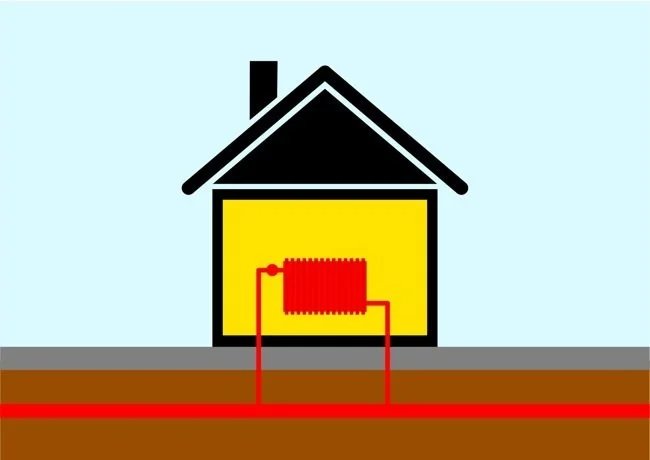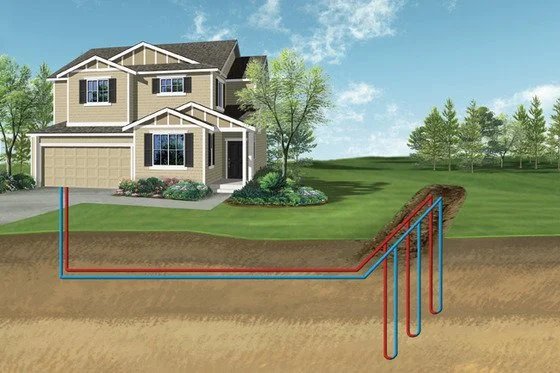We may earn revenue from the products available on this page and participate in affiliate programs. Learn More ›
Geothermal heat represents about two percent of the total heating market in the U.S., with more than 1.3 million systems installed. Also known as a ground source heat pump system, this technology leverages a resource that is free to use—the steady temperature below ground. So, a geothermal system does not burn fossil fuels to create heat; the system transfers heat. That’s the charm: To transfer heat takes less energy than to produce heat.
Getting started isn’t cheap, and payback does not arrive swiftly. For the right homeowner, however, a geothermal heat pump (GHP) can help dramatically offset heating and cooling costs.

How Geothermal Systems Work
To harness the heat stored in the earth, a geothermal system captures and converts that heat for use in the home. System components include a loop of pipe, a liquid to absorb and transfer heat, and a heat-pump unit to process the heat for use.
To capture heat, liquid circulates through a pipe buried in the ground. As it circulates, it absorbs the earth’s stored heat, which remains constant at 50 to 60 degrees Fahrenheit 10 feet below ground level.
The heated liquid enters a heat pump unit. In this unit, the heat from the piped liquid is absorbed by a liquid refrigerant sealed in the unit. That refrigerant evaporates and is compressed, which raises its temperature to about 100 degrees Fahrenheit.
Now a gas, the refrigerant passes through a heat exchanger where the heat is removed and pumped into the house. With the heat removed, the refrigerant cools. It returns to its liquid state and continues to circulate, continually absorbing and using the heat transferred from the earth through the piped liquid.
Types of Geothermal Heating Systems
Geothermal heating systems operate as either closed-loop or open-loop configurations. Determining which loop to use depends on site factors like soil composition, landscaping, and underground utilities.
Closed-Loop Systems
A closed loop uses the liquid solution in a sealed piping loop installed horizontally or vertically underground.
Horizontal loops are used when there is enough usable land available. Pipes are installed in trenches dug about six feet deep and 100 to 600 feet long, depending on the size of the system.
Vertical loops are the only choice when there is limited space available, if the homeowner does not want landscape disturbed, or where many rocks would be encountered when digging. To install the pipe, small-diameter holes 100 to 400 feet deep are bored using well-drilling equipment. Vertical loops are connected to the house via a horizontal underground pipe. When boring for vertical loops, well-drilling codes apply.
A sealed system can also be placed at the bottom of a pond if there is a pond available on the property. Pond loops may be the most economical option because much of the excavation cost can be eliminated.
Open-Loop Systems
An open-loop system uses the heat from well water rather than heat from the earth. Groundwater, which also remains at a relatively constant temperature year-round, is carried into the heat pump unit and the heat is extracted in a method similar to the closed-loop system.
The water does not circulate but makes one pass and is eliminated. It might be released into a ditch, drainage tiles, or a pond. It might also be returned to the water table through a return well drilled into the ground. With concerns about declining and polluted aquifers, however, it’s important to check local conditions and codes before deciding on this type of system.
Geothermal Heat Pump Costs
Initial installation and equipment costs for geothermal heat pumps vary with the maturity of the local market, type and size of the system, and the site. Make no mistake: This is not a DIY.
Adding a geothermal heat pump requires the services of a certified installer, and the drilling aspect alone can end up costing tens of thousands of dollars. In fact, the sheer invasiveness of the project entails labor fees so high that for owners of existing homes, it may not make financial sense to pursue a GHP.
Rough estimates put a geothermal ground-source system at $1,000 to $2,500 per ton of capacity. A ton of capacity, according to the Department of Energy’s Federal Energy Management Program, translates to 12,000 Btu per hour. In heating climates, it is estimated that a ton of capacity is needed for every 550 square feet.
Find a company that is certified, with people trained specifically in geothermal technology, and get more than bid. Ask for references and call those homeowners. Ask to see installations the company has completed.
With your contractor, be sure to discuss the benefits of a hybrid system. A ground-source heat pump can be added to an existing forced-air furnace and can use its existing blower. Dual-source heat pumps are less costly to install and more efficient than the air-source unit alone. Ask about variable-speed blowers and multi-speed compressors on the system to improve comfort and efficiency.

Efficient, Low-Maintenance Heating
Though installing a geothermal heat pump requires a significant initial investment, doing so may be a wise course for homeowners who plan to stay put indefinitely.
Geothermal heat pumps have become quite efficient. Their heating efficiency is indicated by the coefficient of performance, or COP, the ratio of heat provided per British thermal unit (Btu) of energy input. Energy Star-rated geothermal heat pumps have a heating COP starting at 2.8, meaning for every unit of energy used to power the system, 2.8 units of heat are supplied. Meaning, the system delivers more energy per unit consumed than conventional systems—up to 400 percent efficiency compared with 75 to 90 percent efficiency for fossil-fuel furnaces.
According to Jim Bose, executive director of the International Ground Source Heat Pump Association at Oklahoma State University in Stillwater, OK, an existing home with an older furnace could expect an efficiency improvement of around 50% by switching to geothermal. A new home with the best fossil-fuel furnace would expect an improvement of 30%. In 2009, researchers at the Oregon Institute of Technology found that geothermal could save homeowners save anywhere from 20% to 60% annually.
Ongoing maintenance costs compare favorably to those for traditional heating and cooling systems. A properly installed and buried loop can last nearly 50 years. The mechanicals are installed indoors and typically require only periodic checks and filter changes.
Geothermal Heat Pump Water Heating
As it cools the house in summer, a geothermal heat pump creates a useful byproduct: The hot air it removes may in turn be used to heat water (thanks to something called, impressively, a desuperheater). The downside is that during the winter months or in cooler parts of the country, a conventional unit cannot produce enough hot water to meet the average family’s demands. Consequently, a supplementary source of hot water is needed.
Getting the Most from Your Geothermal System
Don’t expect a new system to solve all your home heating problems unless you reduce your heating load. Seal all leaks to eliminate drafts. Check to be sure weather stripping is in good shape and the duct system is not leaking. Consider having a home energy audit done.
Who stands to save the most on utilities over the long term with geothermal? The owners of large homes already incurring steep month-to-month heating and cooling bills. The only hitch is that for a geothermal heat pump to adequately serve a big house, it needs a proportionately larger area of ground from which to draw heat; on a modestly sized lot, that presents a dilemma. One possible solution is to install pipes vertically, not horizontally, but the costs associated with running vertical pipe are often prohibitively high.

